Czapek Place Vendôme Complicité – A Different Take on a Differential
Around and round, I go,
One side fast and one side slow,
Always in a hurry,
Always a bit behind,
Never knew that I was
Key to telling time.
I’m twisted to the left
While I’m torqued to the right,
All while my insides
Are packaged up real tight.
It turns out I have talent
For being in the middle,
Been told I got great balance
With inputs off a little.
It isn’t all that hard,
I do it without a thought,
All because of two great minds,
Out of metal they did wrought.
I ain’t no locomotive,
Even though I am a train,
I’m no solar system,
Yet have planets in my brain.
I really am just different,
Like your brother or your sister,
Call me Differential,
But no first name, please, just Mister.
Ahh, it’s good to be back! And why not start right up with a fun little ditty about one of the coolest forms of gear systems that seem easy to grasp but very difficult to build, Mr. Differential! That sounds like a fun character to be found on a T-shirt, maybe today’s focal brand would want to collaborate on a design for some swag? I have some ideas!
All kidding aside, the differential is a very specific system that can serve a variety of purposes, but in a watch with two separate going trains it seeks to average out two inputs into one single output. That output is the mechanical average of the speed of the inputs (two gear trains regulated by two slightly different escapements) and thus should remain more consistent even if the underlying gear trains changed pace.
It’s a difficult system to create not only because many crucial components are very tiny, but because to have it operate exactly as intended takes a fair bit of math and meticulous design.
If you then put additional tight constraints on that design, the difficulty goes up almost exponentially. Of course, that is what brings us to Czapek and Bernhard Lederer, the brilliant minds behind the stunningly symmetrical Place Vendôme Complicité, a dual gear train masterwork that debuted at Geneva Watch Days 2023.
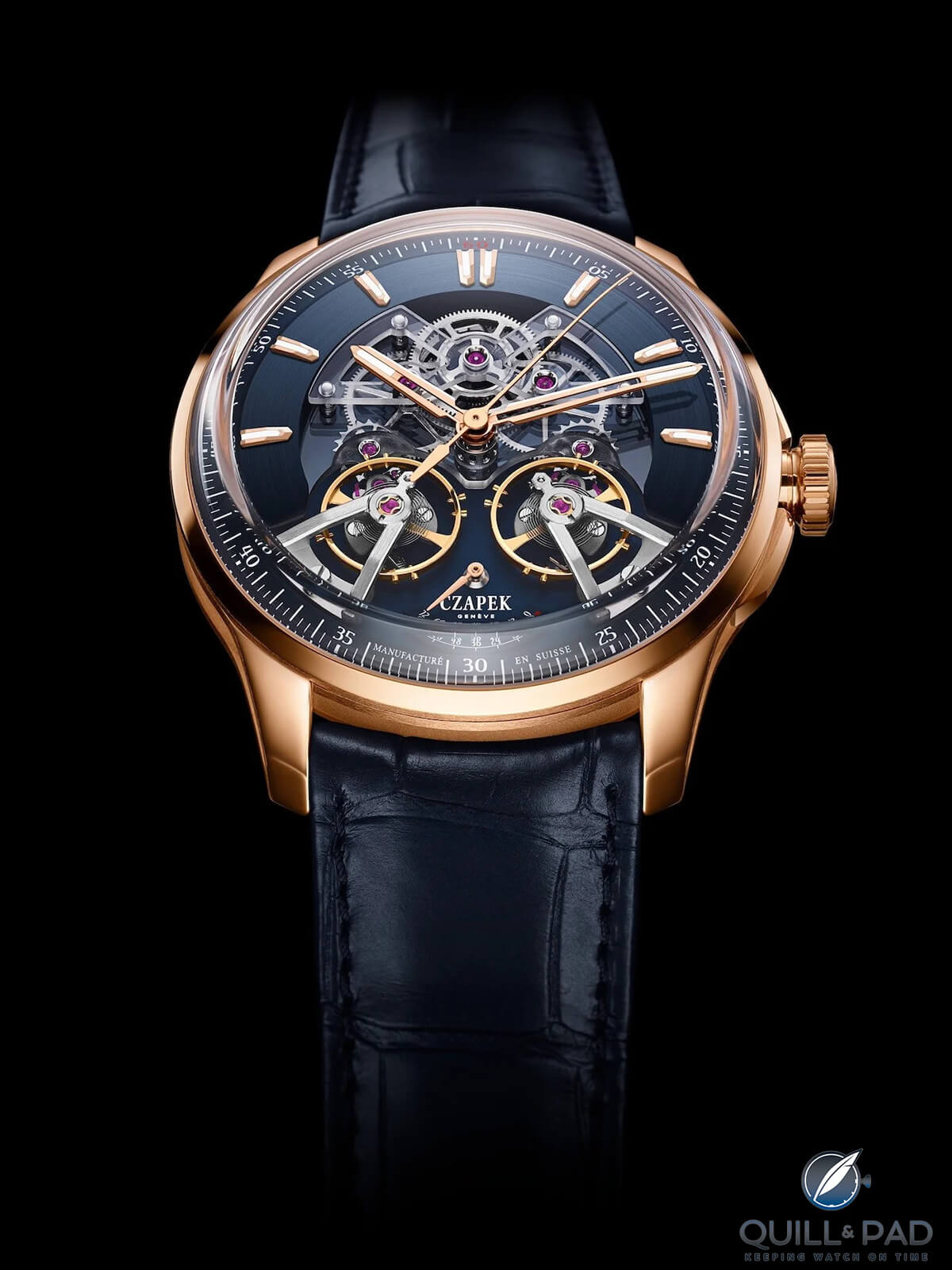
Czapek Place Vendôme Complicité Harmony Blue
Czapek Place Vendôme Complicité
What is this watch, at its core? If you don’t get lost in the dial side mechanics (though if you don’t you probably aren’t reading this), the Place Vendôme Complicité is a “simple” round watch that displays the hours, minutes, and seconds with a small power reserve indicator at six o’clock.
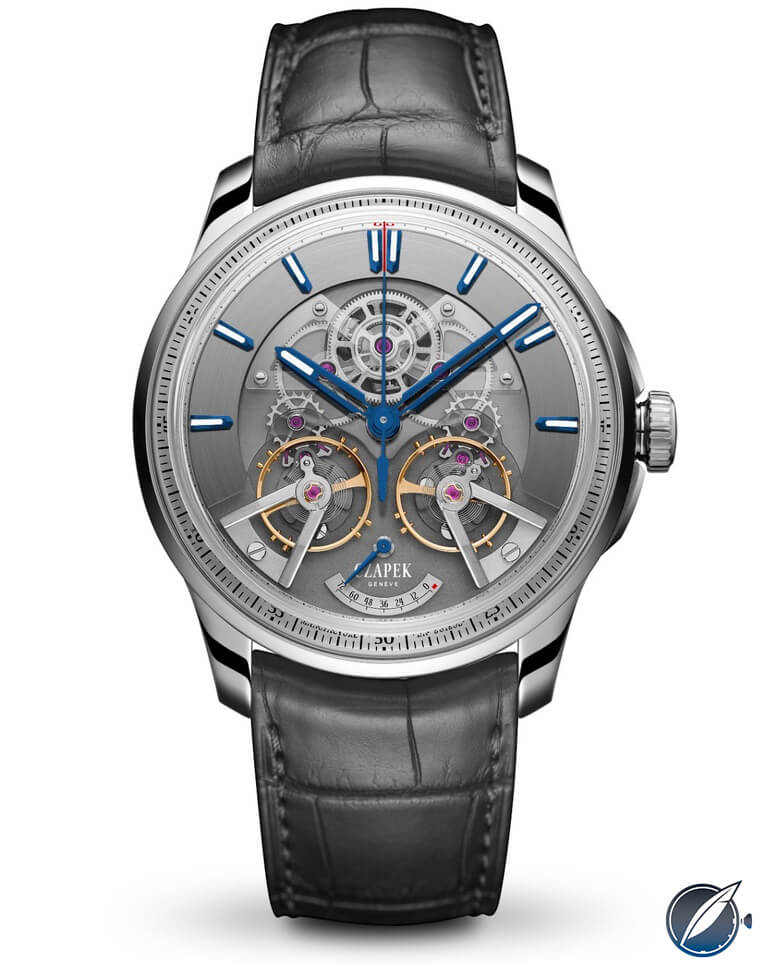
Czapek Place Vendôme Complicité Stardust Cobalt
It’s manually wound with 3 days of power reserve, and slightly large at just under 42 millimeters in diameter. With all of that said, we still have no idea what this watch is, and like an iceberg, the best is all just below the surface.
Built on a new movement, the Calibre 8, the Place Vendôme Complicité uses twin mainsprings joined in a series to power twin gear trains joined by a central differential. This results in dial side twin balance wheels that are seen at 4:30 and 7:30 and twin escapements flanking them respectively near three o’clock and nine o’clock.

Czapek Place Vendôme Complicité Stardust Cobalt
Moving upward on the dial we find mirrored fourth wheels that meet the differential in the center at twelve o’clock.
This perfectly symmetrical layout is highlighted underneath two large, layered sapphire bridges that support everything from the escape wheel to the differential. The two balance wheels are supported by more typical skeletonized steel bridges, in the same vein as the previous Place Vendôme pieces.
That layout, while remaining familiar to the collection, is where the headache for the development of these pieces began because the well-known real estate mantra holds true here: location, location, location.
————————————————————————————————————–
—————————————————————————————————–
Constraints and innovations
Coming as no surprise to those that have ever played Tetris, fitting the mechanical components of a gear train together can be quite the challenge because they are limited in their possible orientations. Just like trying to fit an Orange Ricky and a Teewee together in Tetris, there are only so many permutations of functional gear train layouts and none of them will fit perfectly with everything else regardless of position.
Now add on the difficulty of needing to direct power through a gear train without losing torque, maintaining proper gear ratios, directionality, as well as keeping clear of other moving components, and suddenly designing a gear train to function properly becomes significantly constrained.
Tetris-nerd side note: The original game guide that came with Tetris provided names for all the pieces, and they are wild. The two L-shaped pieces are called Orange Ricky and Blue Ricky, the Z-shaped pieces are the Cleveland Z and the Rhode Island Z, the T-shaped piece is the Teewee, the I-shaped piece is called Hero, and the square block is the cherry on top, named Smashboy. Did I mention this game originated from the Soviet Union?
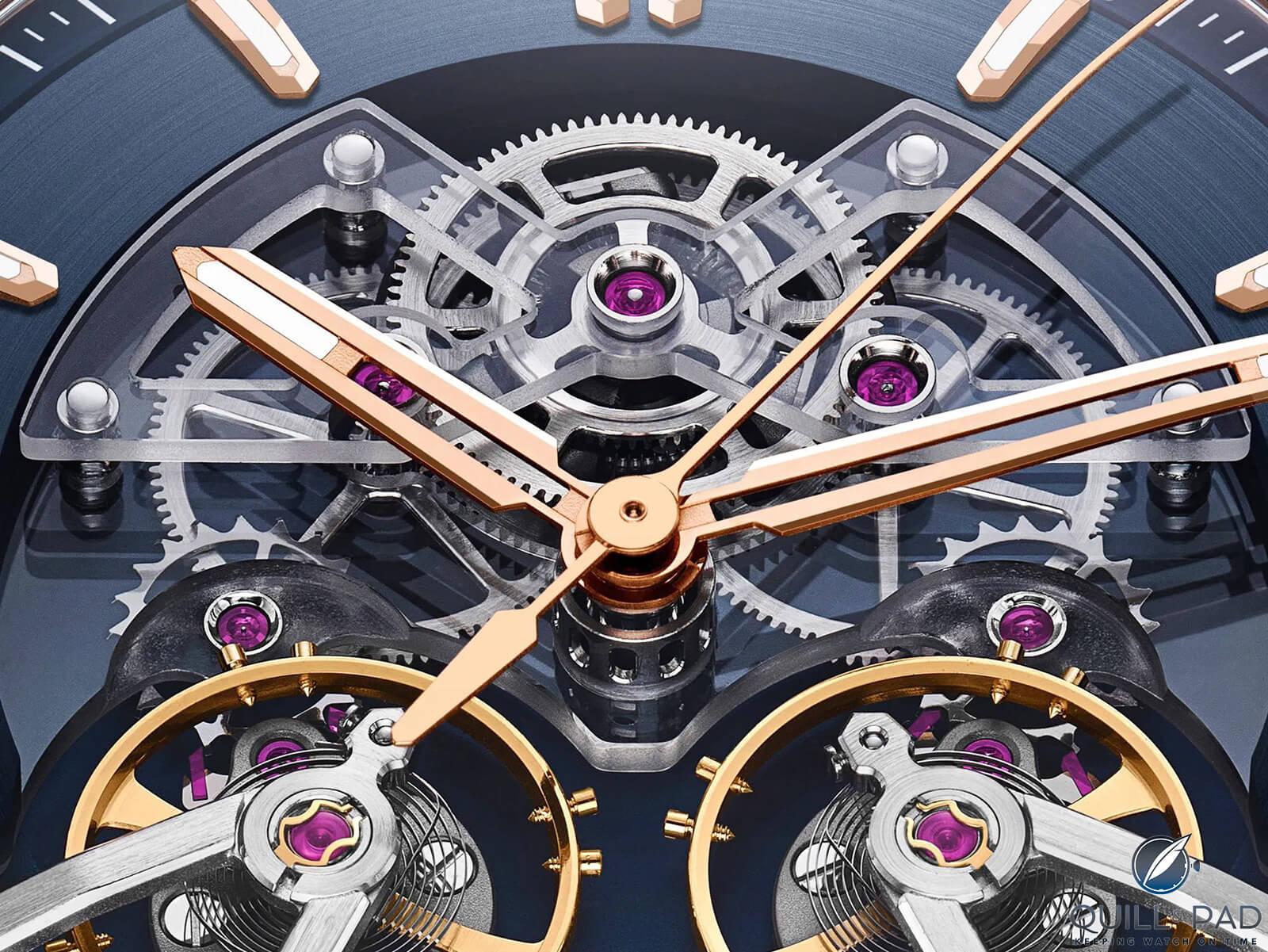
Czapek Place Vendôme Complicité Stardust Cobalt dial details
The only course of action when requiring wheels, bridges, and hands to be located based on an aesthetic design is to move everything not already constrained, create some very custom components, or invent new ways of moving energy around.
Czapek decided to make some custom components and rethought how to get power from the mainsprings to the hands, and of course moved everything else they could to match. So, essentially, they did everything they could to engineer a movement that maintained the desired look and layout of the dial side gear train.
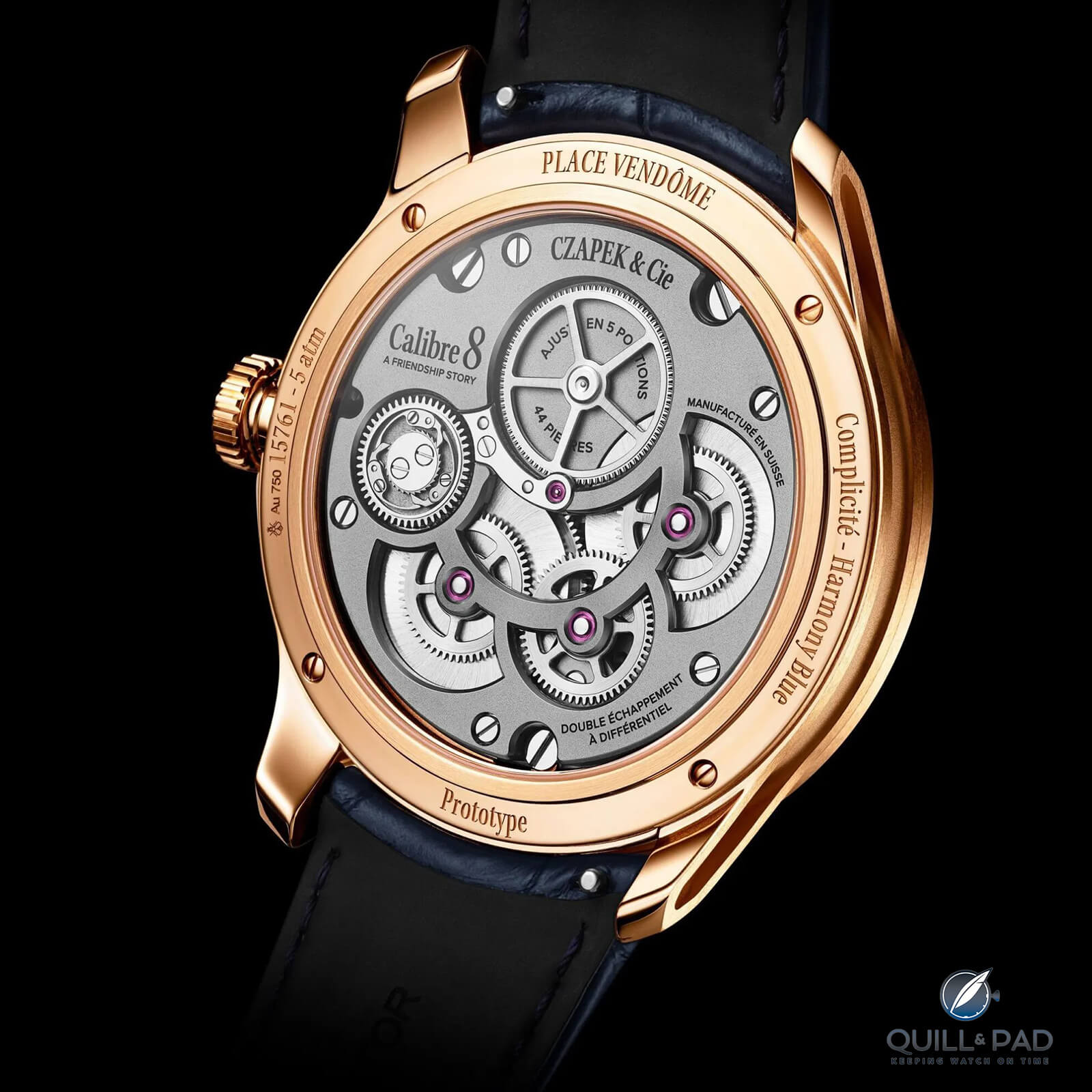
Back of the Czapek Place Vendôme Complicité
From the serially coupled mainsprings (which provide a longer power reserve), the power is driven through the center wheel, keeping the minute hand rotating once per hour. So far this isn’t exactly new ground, but from here we depart into innovative territory, and it’s mostly linked to the need for a center seconds hand.
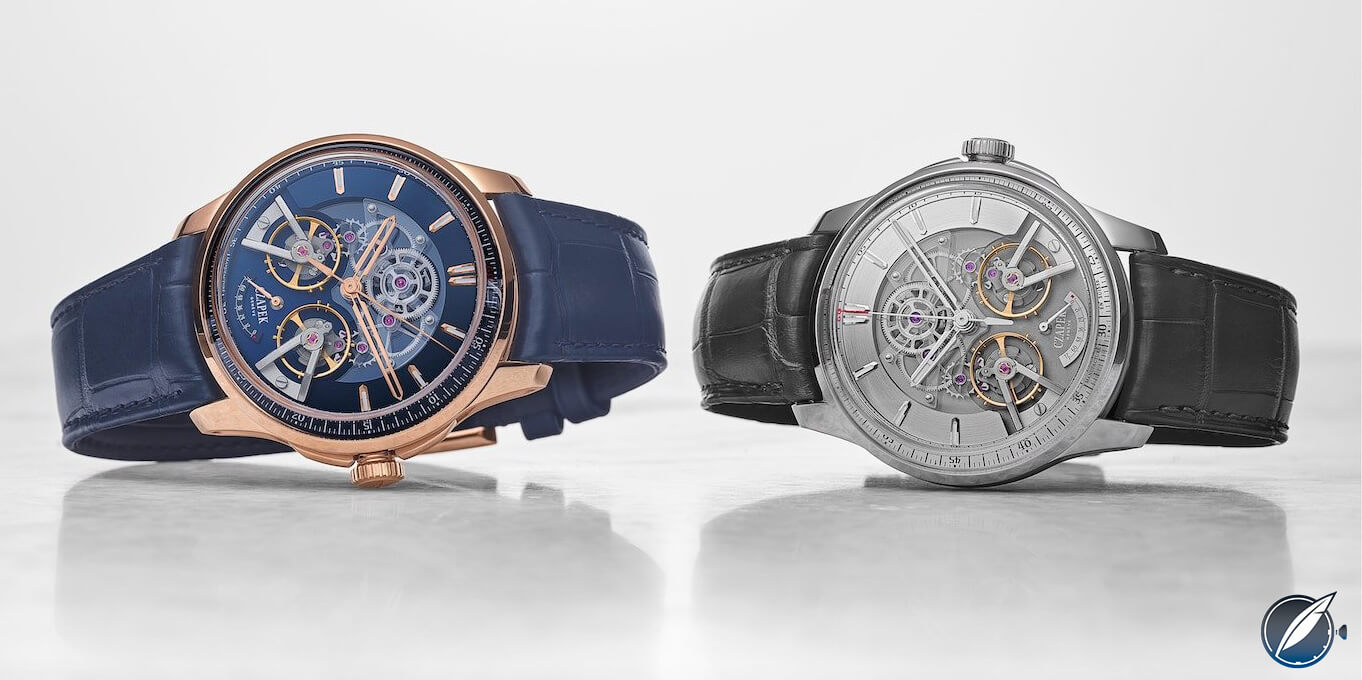
Czapek Place Vendôme Complicité Harmony Blue and Stardust
The typical layout when adding a differential is either to forgo a seconds display or have a sub seconds display tied to one (or both) of the fourth wheels, between the differential and the escapement.
With the symmetrical layout of the Place Vendôme Complicité, those fourth wheels flank the differential at two and ten o’clock, a location where the Place Vendôme originally had no dials or features. Even with the dial side mechanics visible, the desire was to avoid changing the general layout to add an indication of any type in a place there wasn’t one before.
Also, adding a seconds display (something missing from the original model) was crucial to highlight the precision and consistency of the differential.
—————————————————————————————————–
—————————————————————————————————–
Adding complexity for simplicity’s sake
This meant that the center wheel needed to be designed like a traditional center seconds watch with a hollow shaft for the seconds pinion, leading to a new variation to the concept of a differential to achieve this goal. The differential still has the upper and lower third wheel which feed power to each balance assembly, as well as the central planet gears sandwiched between.
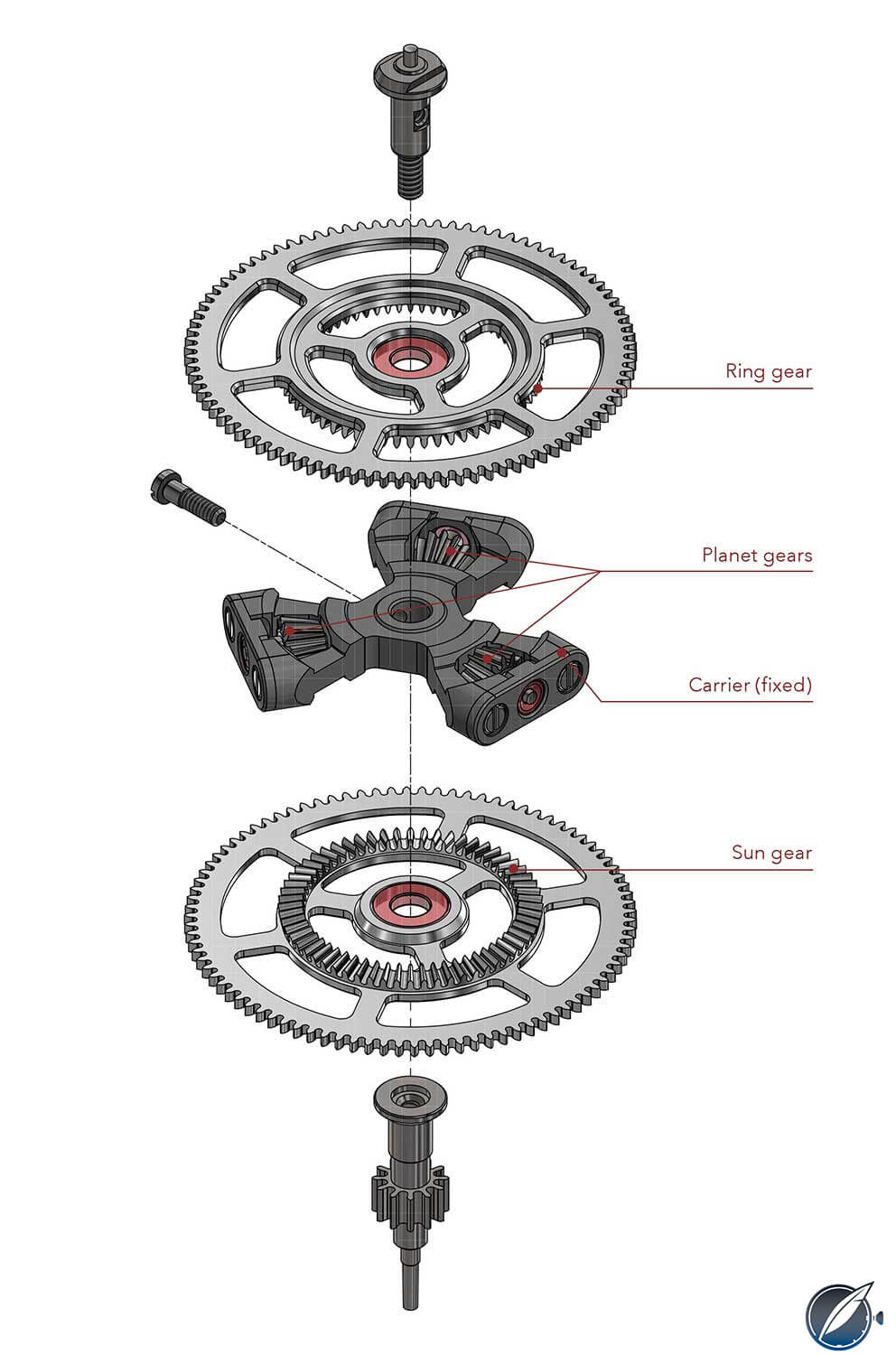
Exploded view of the differential of the Czapek Place Vendôme Complicité
These planetary gears are slightly tapered to provide straight bevel teeth to mesh with the vertical teeth machined on the face of the two third wheels. But this also isn’t too far from the norm, yet if we trace where the power flows, we understand how this brand-new design really works.
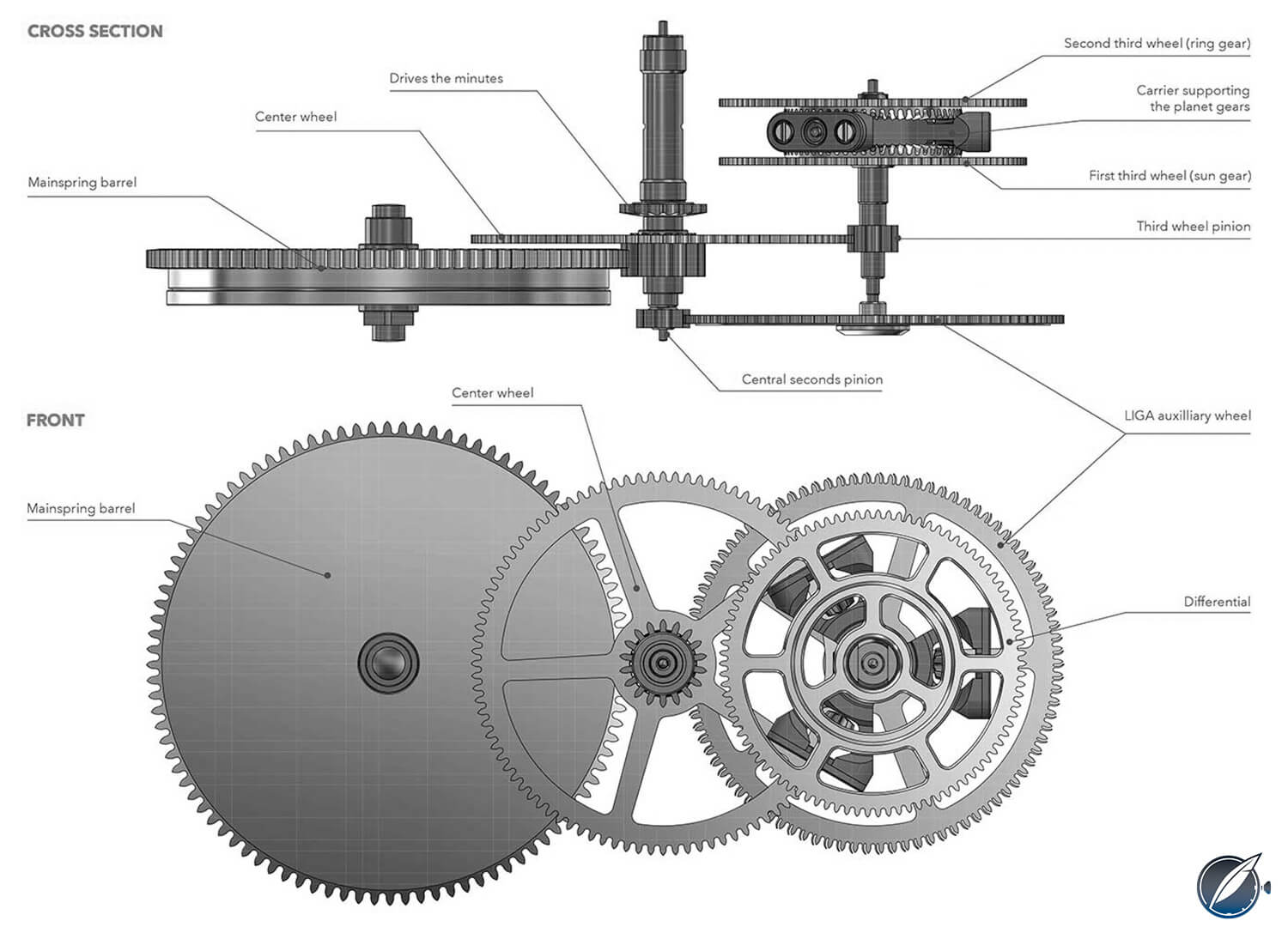
Gearing and differential of the differential of the Czapek Place Vendôme Complicité
The beveled planetary gears ride in a carriage that is fixed to the pivot shaft and driven by the center wheel. This means the carriage and small planetary gears are what drive the top and bottom third wheels, which in turn drive each side’s fourth wheels, the escapements, and the respective balance wheels.

Czapek Place Vendôme Complicité Harmony Blue
The frequency of both balance wheels, which will be slightly different, allows the rotation of the planetary carriage at an average rate between the speed of each gear train, hence the “differential.” But again, this is sort of par for the course when it comes to how differentials work. The big innovation is the addition of an auxiliary wheel affixed to the very bottom of the differential’s pivot shaft.
That auxiliary wheel, produced using LIGA to incorporate sprung, anti-backlash teeth (more on that in a bit), rotates at the same rate as the planetary carriage and allows the power of the mainspring to directly flow back to the time display. The auxiliary wheel meshes with the central seconds pinion, and thanks to three step downs in gear ratios allows for the rotation of the seconds hand at 60:1 from the center wheel.
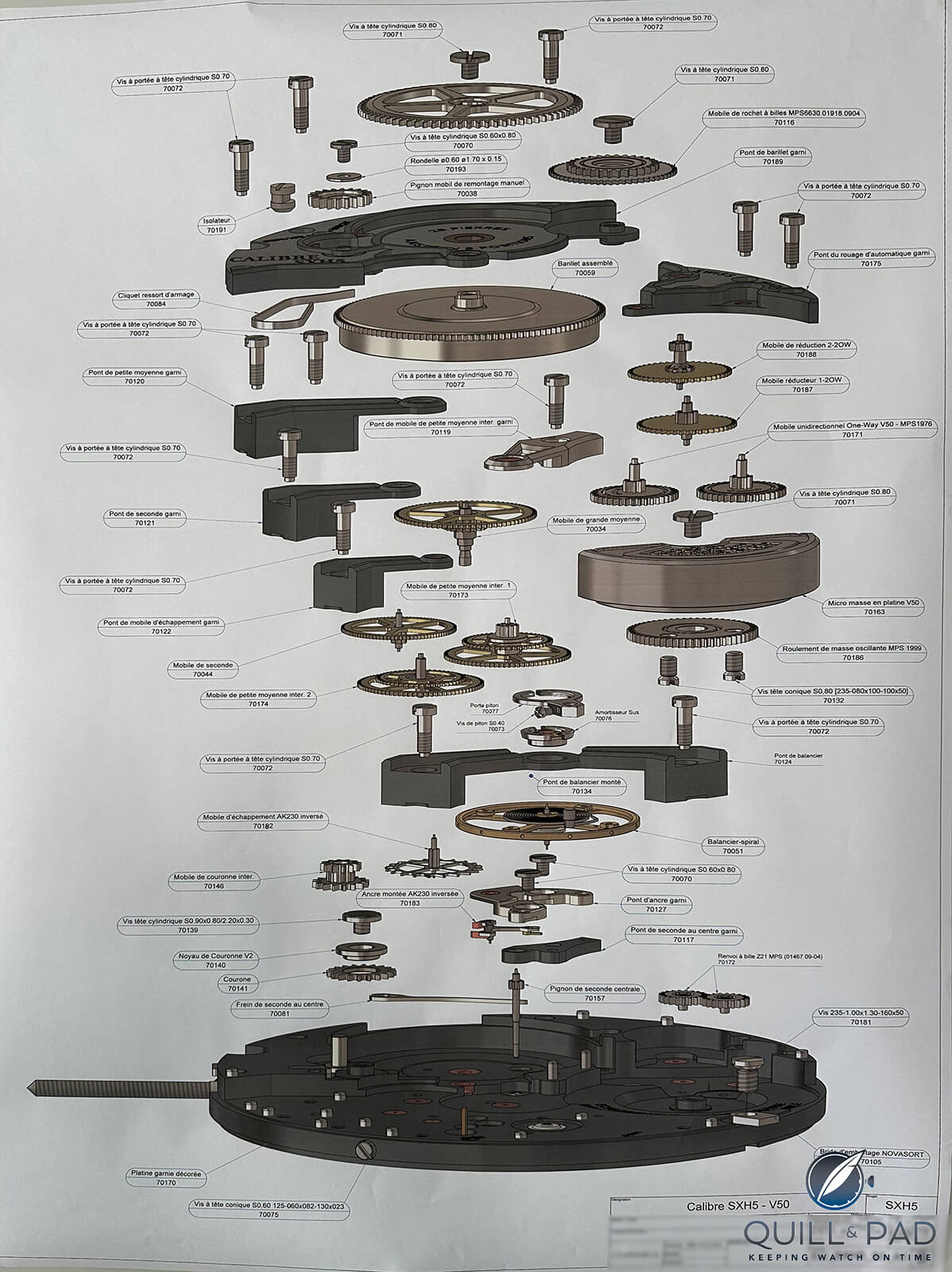
Exploded view of the Czapek Place Vendôme Complicité movement
The auxiliary wheel is actually a very simple solution to look at, but it took careful planning plus the proper position of all the wheels, wheel and teeth sizes, and the appropriate ratios to allow for the minutes and seconds wheels to mesh with a single pivot axis.
The layout of the gear train including the differential is required to work in effectively the same amount of space as a standard center seconds movement, which does lead to a slightly thicker movement as a result, but is incredibly well considered, rivaling a master Tetris player.
—————————————————————————————————–
—————————————————————————————————–
LIGA and backlash
Using the gear train layout to achieve center seconds does avoid added gear train complexity of an offshoot set of gears just for a seconds display, but it introduces issues that must be overcome, namely that of backlash. Whenever a gear train has multiple power outputs from a common shaft there is a possibility of mismatched torque and freedom of movement.
Each gear is designed to allow for a set amount of tooth engagement, measured at the pitch diameter (and controlled by a few other factors, but we can skip those for now), and this tooth engagement allows for a small amount of free play, also known as backlash, to avoid binding between the gears.
That free play reduces wear on the teeth, minimizes friction and, as a result, reduces unnecessary torque loss in the system. Each tooth profile and tooth size have a different amount of play allowed, meaning that multiple gears of different sizes being driven from a shared shaft will have different values for each.
That difference will mean that the gear experiencing the least amount of torque (i.e., the gears that are not being “driven” so much as coming along for the ride) may have the ability to bounce around within the designed free play, introducing shake.
This could mean that the seconds hand could bounce back and forth instead of smoothly “ticking” for each second, making it look jittery and prematurely degrading the teeth. One way to solve this is to reduce the amount of backlash to nearly zero by pushing the two gears together, but any slight deviation in the pivot axes could cause binding or increase free play.
A gear train is a balance of tolerances for every moving component, so each shaft and tooth engagement have some free play, however small, and these can add up to allow for much more free play than is desired.
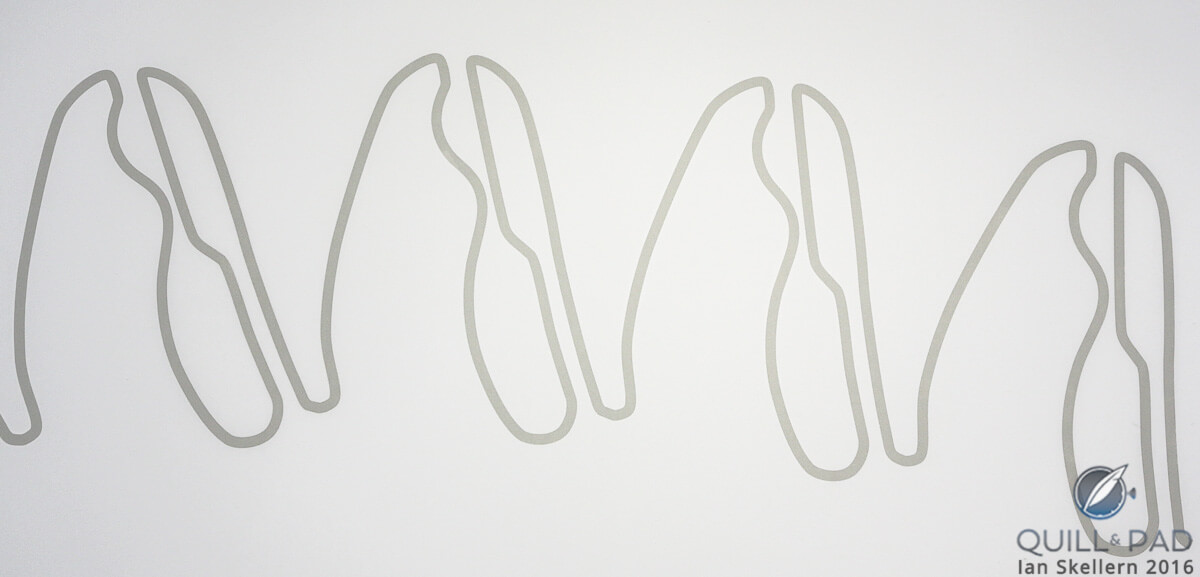
Agenhor flexible gear teeth
To avoid issues with tolerance stack-ups and solve the problem at the source, another solution is to make soft gear teeth that can flex to take up any slack, essentially making a backlash-free connection. Using the ultra-precise LIGA process (of which a detailed explanation can be found in “Looking Back On 10 Years Of Ulysse Nardin’s Pioneering InnoVision Technology”), Czapek was able to create an auxiliary wheel with a flexible tooth profile, which was invented by Jean Marc Wiederrecht at Agenhor.
One side of the tooth profile is a thin spring in the shape of the tooth, designed to sit slightly proud of the standard tooth profile as a way to take up any free play but deform out of the way to keep friction low and prevent binding.
Designing the auxiliary wheel this way allows for a jitter-free seconds hand driven by the same shaft driving the center minute wheel. The pitch diameter can be kept the same so standard tolerance and design parameters can be maintained all while solving a problem using the most precise tooth profiles possible from today’s manufacturing methods.
—————————————————————————————————–
—————————————————————————————————–
Designing a winner
All of these efforts have paid off in creating a stunning movement while maintaining the design language of the Place Vendôme. This may seem trivial to some but for a brand that has always had a strong design culture from the very first watches created after it’s rebirth, being able to design a movement around the desired appearance is still quite impressive.
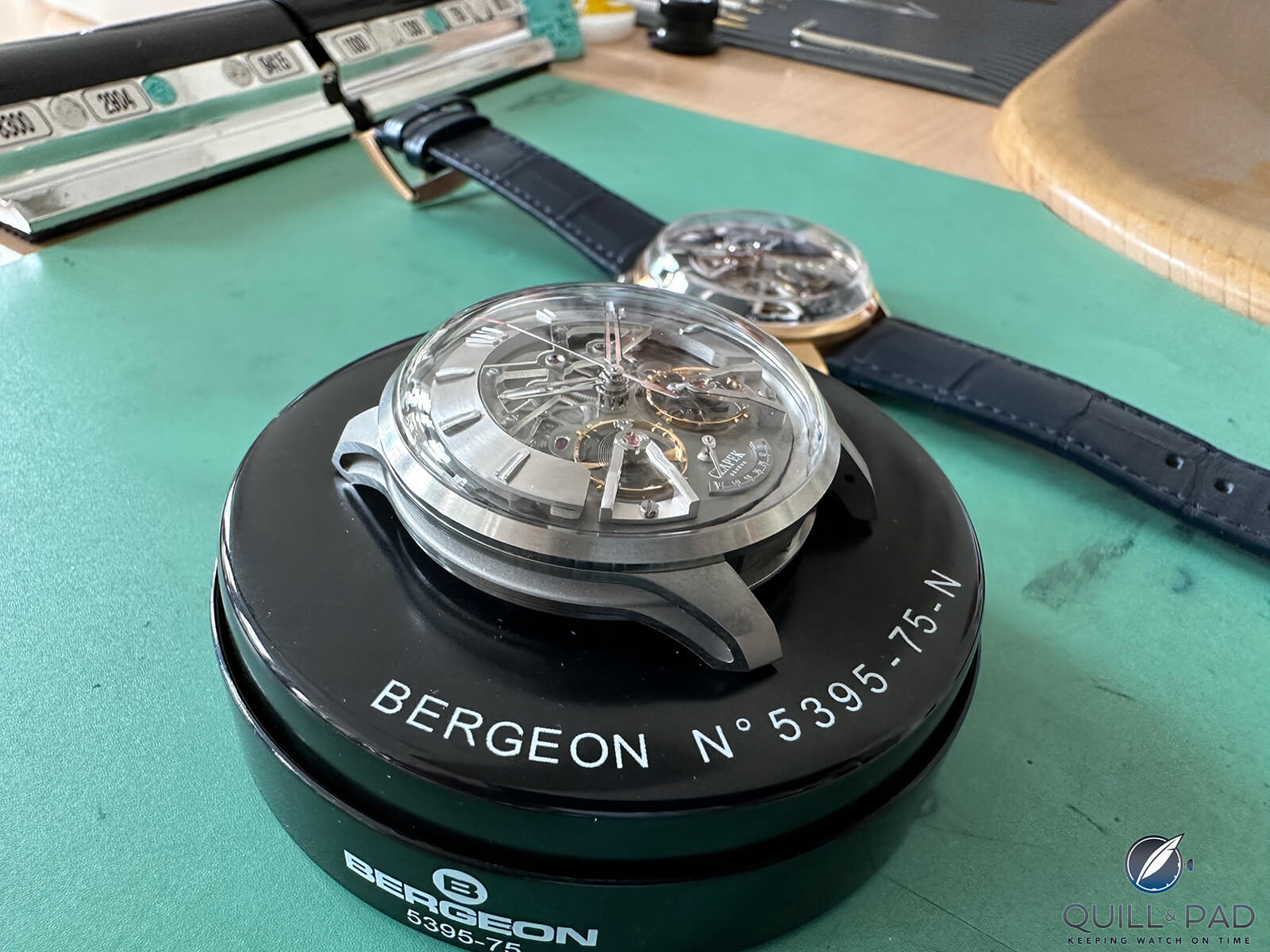
Czapek Place Vendôme Complicité prototype with domed crystal, the first prototype (behind) had a box crystal
Different brands work around this differently, sometimes designing a movement around the idea of what it does, and then letting the aesthetic design be informed by that. Many others will proceed by designing a watch dial layout and letting the movement look like whatever it has to underneath to achieve the needed layout.
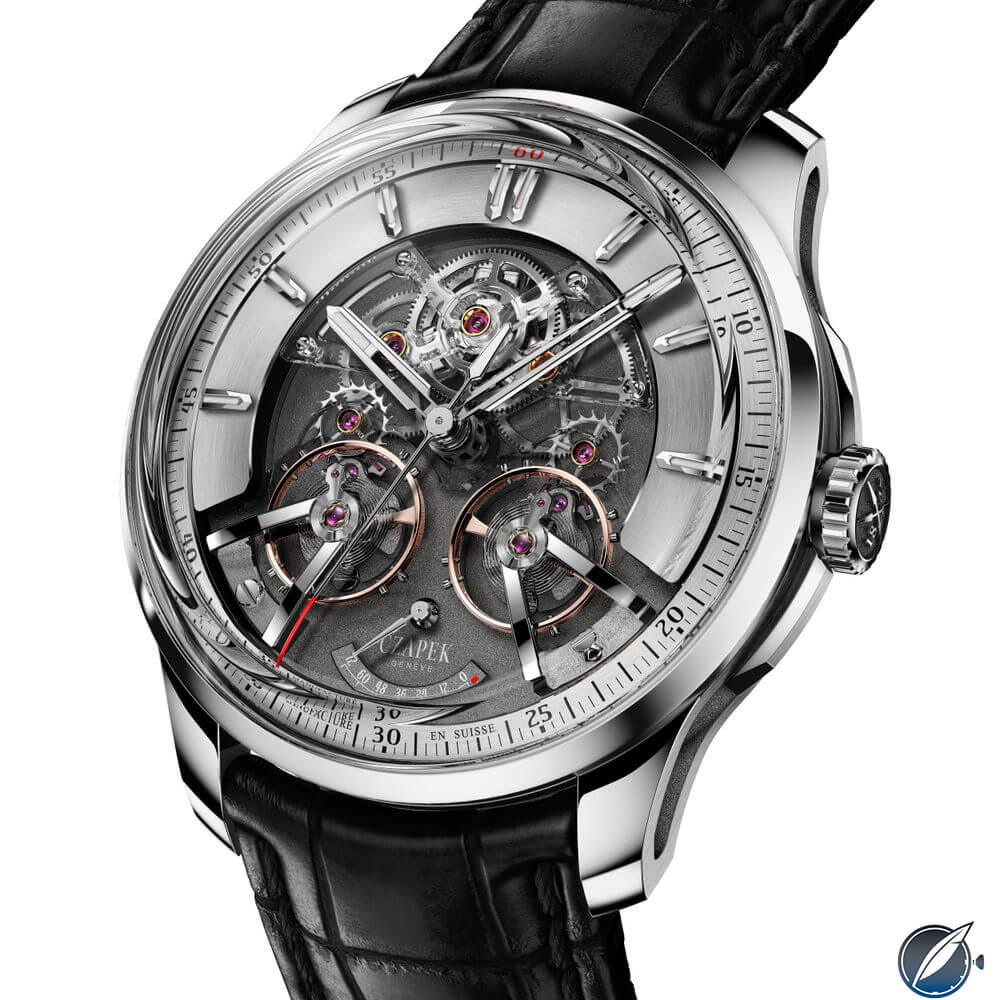
Czapek Place Vendôme Complicité Stardust
But integrally designing a movement and a dial layout is another layer of effort altogether.
The tradeoffs, a factor in any design, are reduced as much as possible by clever engineering and design, so that it looks and works like the concept intended. As someone working in both arenas for my day job, it’s always awesome to see brands that work cohesively between engineering and design.
I truly love the expansion of the original Place Vendôme collection to include something so highly technical while staying true to the original design direction. As we have seen with various other brands across the industry (and in other industries), it is very easy to abandon a design when a fun, new idea comes up that needs to be shoehorned into an already existing design language.
An extension of this desire for cohesiveness is the level of finishing found in the Caliber 8. When the prototypes were first completed, Czapek CEO Xavier de Roquemaurel knew instantly that a movement this incredible deserved the best hand finishing possible. But to keep with the aesthetic already at play in the Place Vendôme, it needed to be consistent.
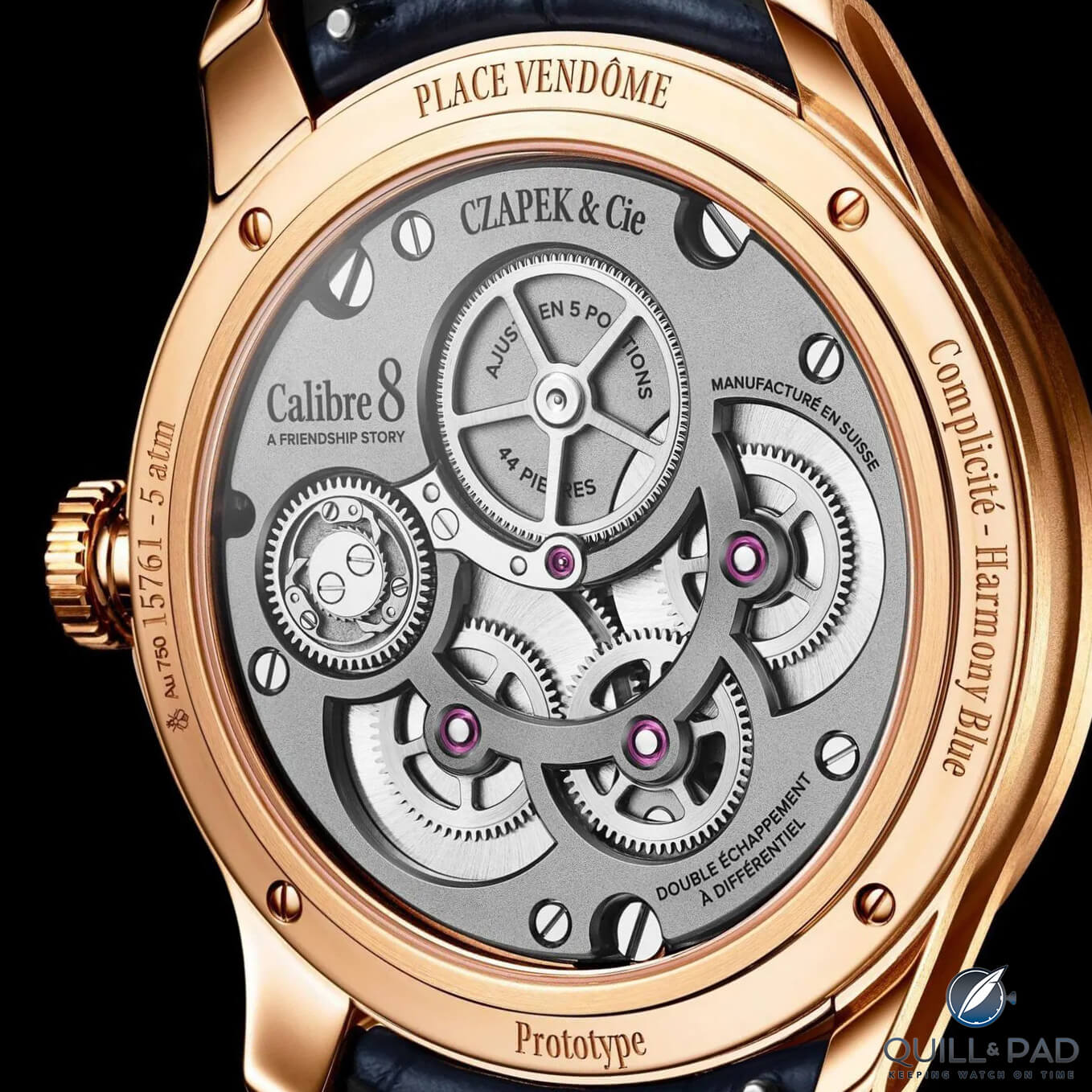
Czapek Place Vendôme Complicité movement
The call for perfection went to Bernhard Lederer and his manufacture (as he is behind the movements) and 18 internal angles were added, perfect frosting was applied, black polishing, circular graining, and a movement that is finished to the highest level was born.
Yet it also maintains continuity with the aesthetic direction of the Place Vendôme and follows a modern slant with subdued style instead of extravagant polishing and excessive beveling.
The Place Vendôme Complicité is an engineering and design winner for Czapek, a brand that could have easily leaned too heavily into the incredible success of the Antarctique and all it’s variations. But we have seen the launch of multiple iterations of the Place Vendôme Complicité, and the new Promenade collection with a heavy emphasis on design, demonstrating that Czapek is actively avoiding becoming a one-trick pony.
Putting so much effort into movement engineering will always be a good sign that a brand values innovation, creativity, and is forward looking. Combining that effort with consistent thoughts on design and aesthetics will always be a good sign that a brand isn’t going to leave any detail ill-considered or forgotten.

Czapek Place Vendôme Complicité Stardust
That leads to amazingly solid and purposeful watchmaking, and a future that relies not on fad or flash-bang trends, but quality products built by people that care about the people actually wearing their watches.
I look forward to new inventions and new models, as well as carefully considered designs that are sure to come from Czapek!
- Wowza Factor *9.59 Dial side mechanics always grab me, and twin balance wheels are an easy way to take something to a super high level!
- Late Night Lust Appeal * 95.9 » 945.458m/s2 There have been many evenings where I have gazed into the depths of the Caliber 8 unable to get to sleep!
- M.G.R. * 67.7 Twin balance wheels with a differential can’t get much better, unless we had concrete data on how precise and consistent the movement was!
- Added-Functionitis * Mild A power reserve still is one of the best added functions for a manually wound watch, but with this being the only extra I would only recommend children’s strength Gotta-HAVE-That cream for the dual horological swelling!
- Ouch Outline * 12.4 Stubbing the same toe every day for a week! Weeks can be rough for various reasons, but continuing to persistently smash the same toe into chairs, boxes, dressers, and table legs will have you cursing the fates come Friday night. Still I would gladly take this punishment if it meant getting the Place Vendôme Complicité on my wrist!
- Mermaid Moment * Look at those tiny spring teeth! Dual balance wheels aren’t common, but they are definitely becoming less rare. Still, the advanced manufacturing techniques at play with this watch are enough to make a guy start looking at tuxedos!
- Awesome Total * 836 Start with the caliber number (8) and add it to the number of hours of power reserve (72), then multiply the result by the diameter of the case (41.8), then divide by the total number of variations made to date (3+1) for a mechanically awesome total!
For more information, please visit www.czapek.com/czapek-watches-collection-place-vendome.
Quick Facts Czapek Place Vendôme Complicité
Case: 41.8 x 13.3 mm, 18k white or rose gold
Movement: manually wound caliber 8 (in collaboration with Bernhard Lederer’s MHM), 72-hour power reserve, 21,600 vph/3Hz with dual balance wheels
Functions: Hours, minutes, seconds, power reserve
Limitation: 50 pieces for each Stardust (white gold & grey dial), Harmony Blue (rose gold & blue dial), 13 pieces for Stardust Cobalt (white gold & grey dial with blued markers and hands)
Price: 85,000 CHF
You might also enjoy:
Czapek & Cie Promenade WatchesCollection: Ripples and Rays
Czapek Antarctique Green Meteor: Cosmos to the Wrist
Czapek & Cie Antarctique Frozen Star S: Featuring a Scintillating (and Ultra-Rare) Osmium Dial
Czapek Antarctique Tierra Adélie & Orion Nebula: The Restraint Stands Out
Leave a Reply
Want to join the discussion?Feel free to contribute!



Dear Joshua,
Thank you for a read more interesting than an already very interesting watch. Special mention to the close up photo of the sapphire bridge, easily the best horological image I’ve seen in a long time.
Regards
Ed